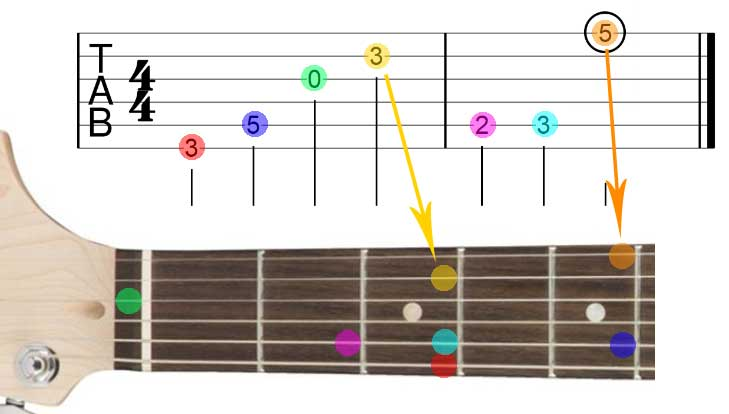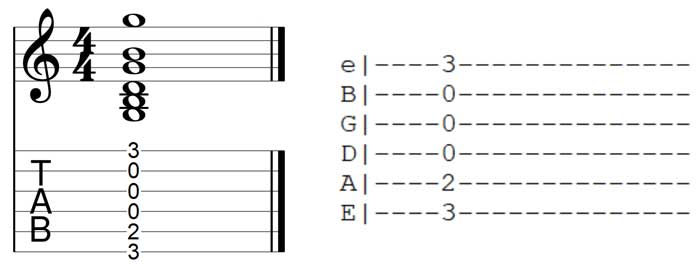Text-based Guitar TAB
This is the first type of Guitar TAB that became popular online. Text-based Guitar TAB is written in a simple text file as shown below.

Text-based and formal Guitar TAB sometimes displays the string tunings for each line as shown below:

The key point to remember is that the top line on Guitar TAB matches the highest pitch string on your guitar and the lowest line matches the lowest pitch string on your guitar.

What Do Numbers Mean on Guitar TAB
Each line on Guitar TAB matches a string on your guitar. Whenever you see a number on a line in Guitar TAB, it is an instruction to play a specific note on that string.
The numbers on Guitar TAB represent the fret numbers on a string. 5 would mean the fifth fret on your guitar. 12 would mean the twelfth fret. 0 would mean the open string (zero fret).
Take a look at the below diagram for examples of different Guitar TAB numbers and how each number matches a note on the guitar:

There are two ways numbers can be written in Guitar TAB and it affects the way you play them.
Numbers Stacked on Top of Each Other
When numbers on Guitar TAB are stacked on top of each other, it is telling you to play those numbers at the same time. In other words, strum a chord.

All of the above numbers in the Guitar TAB are stacked on top of each other and if you play them all at the same time, you end up with a chord.
Take a look at the below Guitar TAB and think about what is being played (or try to play it yourself):

While it may look confusing, it is simply asking you to strum an E minor chord eight times.
Numbers Written Left to Right
When numbers are written side by side (on the same string or different strings), the Guitar TAB is telling you to play the notes one after the other from left to right.
We read Guitar TAB just like you’re reading this sentence – from left to right one word at a time.
In the below Guitar TAB, you start by playing the 1st fret note, then play the 2nd fret note, then the 3rd fret note, and finally the 4th fret note because they are all written one after the other.

It doesn’t matter if you see a single-note or a chord, read everything left to right.
The key point to remember is that you only play a string on your guitar when you see a number on that string.
If you don’t see a number on a string, it means not to play anything on that string.
What Do Symbols Mean on Guitar TAB
Now that you know what the lines and numbers represent on Guitar TAB, let’s look at the important symbols used.
Symbols on Guitar TAB represent different guitar techniques such as slides, bends, hammer-ons, palm-muting, and more. When you see a symbol in Guitar TAB, it is telling you to perform a specific type of technique.
There are two sets of symbols to learn for Guitar TAB. Text-based Guitar TAB uses one set of symbols and formal Guitar TAB uses a different set of symbols.
Let’s go through all of the main symbols you will likely see in Guitar TAB.
What does h mean in Guitar TAB
‘h‘ in Guitar TAB is short for ‘hammer-on’. This is when you play a note and hammer-on to a higher note.
In text-based Guitar TAB this is shown as ‘h’ in between two notes. In formal Guitar TAB, this is shown as a curved line over the two notes as shown below and an H above the staff:

Both of the above Guitar TABs are showing the exact same thing to play.
2h4 means play the 2nd fret, then hammer-on to the 4th fret. 2h4h5 means to do two hammer-ons in a row (you only pick the first note).
What does p mean in Guitar TAB
‘p‘ in Guitar TAB is short for ‘pull-off’. This is when you play a note and pull-off to a lower note. It’s basically the opposite of a hammer-on.

The same curved line is used in formal Guitar TAB as is used for hammer-ons, so you simply need to look at whether the number is higher or lower to know which technique to use.
Hammer-ons and pull-offs can be combined (known as legato) all under the same curved line as shown below:

This can also be combined with slides as shown later.
What does / or \ mean in Guitar TAB
A slash ( / or \ ) in Guitar TAB is the symbol for a slide.
The type of slash used tells you whether you need to slide up to a note ‘/’ or slide down to a note ‘\’.
To know which slash symbol is which, think of the slash symbol as a slide you walk up to from the left. If the slash slopes downwards like \, you slide down on guitar. If the slash slopes upwards like /, you slide up on guitar.

The same symbols are used in text-based and formal Guitar TAB so it’s easy to identify slides. Some old text-based Guitar TAB may show s instead of a slash (eg: 7s5).
In formal Guitar TAB, you may also notice a curved line over the top of the slide, this is a reminder that you only pick the first note of the slide. If there isn’t a curved line, it means to pick both notes.
What does b mean in Guitar TAB
‘b‘ in Guitar TAB is the symbol for a bend. In formal Guitar TAB, a curved line with an arrow or number is used.

In text-based Guitar TAB, sometimes a number is given after the ‘b’ to tell us what pitch to bend up to. So 7b9 means to bend the 7th fret note up until it sounds like the 9th fret pitch.
Some older text-based Guitar TAB found online use the symbol ^ to represent a bend.
In formal Guitar TAB, a number is given at the top of the curved arrow to tell us what type of bend to play.
‘1/2’ means a half-step bend, ‘full’ means a whole-step bend, ‘1 1/2’ means a one-and-a-half step bend and so on.
‘r‘ in Guitar TAB means to release a bend. Sometimes this is shown if a bend needs to be held for a long time, so you know when to lower it again.
‘pb’ in Guitar TAB means to pre-bend a note before you pick it. You push the string up to the correct pitch, then pick the note before releasing it or holding it.
What does x mean in Guitar TAB
‘x‘ in Guitar TAB is the symbol for a muted hit or rake. This can be across multiple strings or on a single string.
A muted hit is when you lightly place your fingers over the strings and hit them.

Think of a funk guitarist playing some percussive rhythms on his guitar without chords ringing out. Those are muted hits.
What do parentheses () mean in Guitar TAB
When a note is in parentheses () in Guitar TAB, it either means to play a ghost note or that the note is continuing to ring out.
In the below example, the notes in parentheses are ghost notes. This means you need to play the notes in the parentheses softer than the rest of the notes.

Sometimes ghost notes are shown to represent the repeated notes you hear from a delay pedal.
In the below example, the note in parentheses isn’t a ghost note. Instead, the parentheses tell you that the note has continued to ring out into the next bar and you don’t pick it again.

Normally when a note rings out to the next bar, parentheses are used to show that the note is still ringing out.
What does ~ mean in Guitar TAB
‘~‘ in Guitar TAB is the symbol for vibrato. In text-based Guitar TAB, this is usually displayed on the line next to the note and formal TAB shows a wavy line above the staff.
Some old text-based Guitar TAB uses v next to the note to show vibrato because the ~~~ can be hard to see.

While ~ is the symbol for vibrato, quite often the symbol isn’t used because the guitarist uses vibrato so often it would make the sheet music messy to include it on every held note.
So if you don’t see a vibrato symbol in TAB but you can hear it in the song, that’s why it wasn’t noted.
What does <> mean in Guitar TAB
‘<>‘ in Guitar TAB is the symbol for natural harmonics. When you see a note in between the two symbols such as <12> it means to play a natural harmonic on that fret.

symbol in Guitar TAB” width=”900″ height=”199″>
Some Guitar TAB will show N.H. above or below the staff to indicate the note is a natural harmonic. You may also see A.H. for artificial harmonics.
You may also notice that the notes in the standard notation staff show as diamonds when a harmonic is used.
The <> symbol may also be used to indicate volume swells, so listen to the song to know which is more likely.
What does t mean in Guitar TAB
‘t‘ in Guitar TAB is the symbol for tapping. This is sometimes displayed above the staff with a capital T, while other times it is displayed next to the note (usually on text-based TAB).

The curved line over all of the notes in formal Guitar TAB reminds us that all of this is played without picking (legato).
As you can see, tapping in text-based Guitar TAB can get really confusing and hard to read. When I was learning guitar I would print out the TAB and use a highlighter to clearly see which notes were tapped.
What does PM mean in Guitar TAB
‘PM‘ in Guitar TAB is the symbol for palm muting. This is usually displayed above or below the staff and is followed by a dashed line if the palm muting is held for a long time.

In the above example, you only play palm muting when there is a PM or dashed line below or above the staff. The other notes are played without palm muting.
In some older text-based Guitar TAB, this symbol may not be used at all if the song heavily uses palm muting.
For example, in some metal songs, almost the entire song uses palm muting. It would be messy to add a dashed line to every note, so it is often left out.
Guitar TAB Symbols Summary
Here is a quick guide to the most common symbols you will see in text-based Guitar TAB:
- h = hammer-on
- p = pull-off
- b = bend
- / = slide up
- \ = slide down
- PM – – – – = palm muting (above or below TAB)
- ~~~ = vibrato
- x = muted hit
- <> = natural harmonics
- t = tapping
- () = grace note or let the note ring out
There are many more symbols that can appear in Guitar TAB, but the above covers all of the essentials you are likely to see.
Reading Guitar Tabs